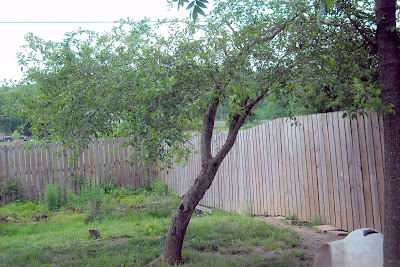When we bought this house 7 years ago, it came with a large, overgrown apple tree in the backyard. We have harvested a lot of small (2-3") green apples from it over the years. They made passable jelly and apple sauce.
Tired of small fruits, we decided to try to increase our fruit size and quality. We started by pruning this unruly tree in late winter. Then, as the fruits appeared in early May, we thinned them by hand. What a difference it made! It turns out that our tree is not a green apple tree after all! The apples are growing much quicker than previous years and are starting to turn red. Our apples were never ripening. It will be interesting to see what kind of apples this tree is supposed to produce! We added to our "orchard" with two dwarf apple trees planted in pots this spring.
Thinking about planting apple trees? It's not difficult. Here's what you need to know.
All apple trees consist of a tree grafted to root stock. The tree portion determines what kind of apples your tree will produce, while the root stock determines final tree size. The neat thing about this is that an apple tree can be made to fit in almost any yard.
Dwarf trees (pictured at right)
- need as little as 8' of horizontal space
- grow 4-8' tall
- can be harvested and sprayed without ladders
- some varieties can be grown in pots
- produce 30-40 full sized apples per tree when mature
- must be staked as they grow larger because dwarf rootstock does not hold a tree up well
Semi-dwarf trees (pictured below)
- need 15' of horizontal space
- grow 10-16' tall
- require pruning to maintain shape and height
- require ladders to pick the upper branches
- produce a large crop when mature
Standard trees
- need 40' of horizontal space
- grow 30' or taller
- require a cherry picker to prune and harvest the upper reaches
- produce a large crop, but thinning and picking all fruits is virtually impossible
Tip and Tricks:
- It takes 3-5 years to get fruit, but apples trees can produce for decades so start as soon as possible
- Plant from late fall to early spring
- Water new trees very well for the first year
- Don't plant in low pockets of land as these places will hold cold air in the spring, potentially frosting blossoms
- The fruits will try to grow in clusters (see picture above); when they reach the size of dimes pick off the smallest fruits leaving only one apple per 6" of branch
- Prune vertical and interlacing branches each winter
- Plant at least two different varieties of apple trees (a crabapple will work as well) for cross-pollination making sure that the trees will bloom at the same time in the year
- Planting dwarf varieties that mature at different times of the year can ensure a constant harvest without consuming much yard space or producing too many apples at once
- Plant the graft juncture above the soil line
- Contact your county extension agent for advice on which varieties work best in your area
- Also contact your county extension agent if insect or disease problems arise (if you want to stay organic, make sure they know that)








